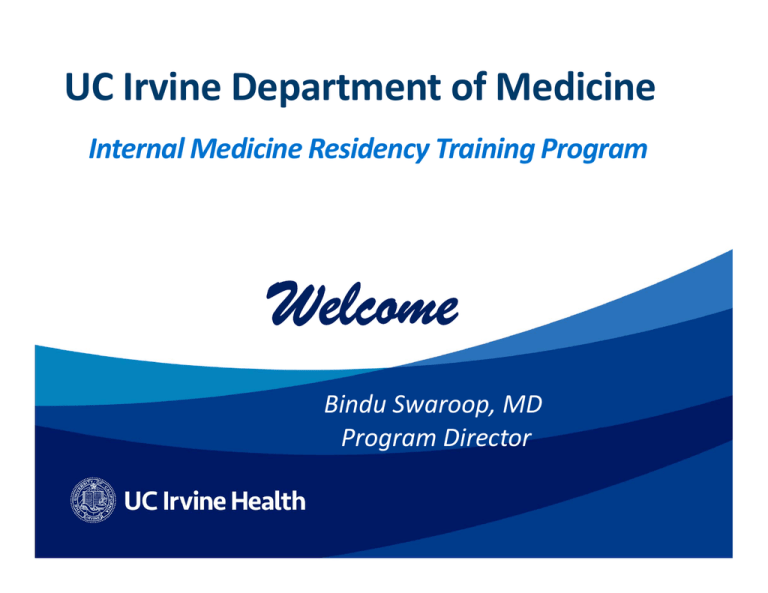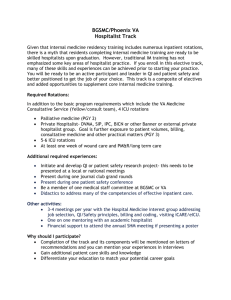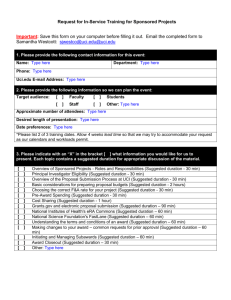Welcome UC Irvine Department of Medicine Internal Medicine Residency Training Program Bindu Swaroop, MD
advertisement

UC Irvine Department of Medicine Internal Medicine Residency Training Program Welcome Bindu Swaroop, MD Program Director Internal Medicine Residency Training Program University of California, Irvine We are very pleased that you are considering our Internal Medicine residency, and we look forward to meeting you. In this presentation, we have highlighted the most salient information about our Program. More extensive information is available on our website: www.medicine.uci.edu/intmed. Please also feel free to e‐mail me with questions at bswaroop@uci.edu Bindu Swaroop, MD, Program Director 2 UCI Internal Medicine Residency Core Philosophy & Goals Our Mission To provide outstanding training that is comprehensive, innovative and prepares residents to be exceptional providers and life‐long learners. To foster a love of knowledge, altruism and the highest respect for intellectual integrity and curiosity. Our Vision To continue as a premier Internal Medicine training program, enhance our pledge to academic training and foster the highest commitment to individual patients and our community 3 Department of Internal Medicine| 2013‐2014 UCI Internal Medicine Core Philosophies & Goals By the end of training our residents will be: •Clinically astute •Academically rigorous •Committed to the highest professional standards •Able to access the broadest range of career options 4 Defining Program Characteristics Diversity of Training Experiences • Our residents train in diverse environments and with unique patient populations. • Our hospitals include the primary teaching hospital of the University of California, Irvine; the Long Beach Veterans Health System Hospital; and Long Beach Memorial Medical Center • Our outpatient clinics range from indigent care sites to faculty private practice to our NCI‐comprehensive Chao Cancer Center 5 Broad experiences at three hospitals • UC Irvine Medical Center – 45% (diverse population) • Long Beach VA Medical Center – 45% (“bread & butter”) • Long Beach Memorial Medical Center – 10% (ICU) 6 Internal Medicine Residency | 2013 ‐ 2014 UCI Medical Center (UCIMC) University hospital with 400 active beds 100 total IM Beds • General medicine • Hospitalist and consult team experience • ICU/CCU • Oncology As the faculty’s and community’s hospital we attract a wide range of ethnicity, disease and social status Uniquely a student and resident hospital: No “private patients” 7 Long Beach VA Healthcare System • Recently updated and refurbished • Great depth of common Internal Medicine illnesses • Exceptional academic faculty, full members of the Department of Medicine • Outstanding clinical and basic science research • Resident & student oriented health system • Important resource in geriatrics training 8 Long Beach Memorial Medical Center • Outstanding facility with an IM Associate Program Director • Long‐standing commitment to teaching with programs including IM, Surgery, Pediatrics, Ob/Gyn, EM, PM&R, cardiology, pulmonary medicine and radiology • Cardiology, Neurology, and ICU Teaching Services with dedicated, supervising teaching faculty • Excellent practice‐based ambulatory and subspecialty experiences in areas such as women’s health, cardiology, allergy, oncology, & emergency medicine • One of the top centers in the country for cardiac care 9 Community‐based Sites • UCIMC Continuity Clinic with a unique practice model • VA Continuity Clinics with a novel team based approach to care (Patient Aligned Care Team‐ PACT) • UCIMC Faculty Practice Sites • Continuity clinic protected without back‐up responsibilities • Dedicated ambulatory curriculum on clinic rotations 10 Defining Program Characteristics Diversity of Patient Populations • We serve an extraordinarily diverse patient population including long established and recently immigrated communities. • We serve patients across the economic spectrum. More than 50% of our patients are economically disadvantaged. • Neighborhoods in our area include persons from China, the Middle East, Southeast Asia, Latin America, Persia and many others. • We care for patients with conditions like leprosy, TB, rheumatic heart disease and HIV as well as the breadth of diseases seen in the general US population. 11 Defining Program Characteristics • We present unique, longitudinal curricula in clinical skills, EBM, Quality, and Palliative Care. • Each house officer has at least 9 months of elective time for clinical, research, externship, or international experiences, with 2 elective blocks (6 weeks) in the first year. • We are committed to our mission of education and measure service in the context of educational value. 12 Defining Program Characteristics • Our flexible curriculum allows residents to tailor their experience to their career track. • We encourage couples matching. • We offer coordinated acceptance for IM & Occupational Medicine. • We offer career pathways in research, hospitalist medicine and primary care. 13 Curriculum Development: Recent Innovations • Doctoring Skills Rotation • Resident‐Driven Process Improvement Programs • Fellowship & Career Mentoring from the first day of orientation • A Curriculum in Life‐Long Learning Skills to enhance commitment to knowledge and • The Science of Decision Making skills after graduation Conference • Business of Medicine and Career • Resident Morale Project to continuously identify ways to Development improve the well‐being of our residents • A longitudinal curriculum in Teaching Skills for all residents • Academy of Internal Medicine • An experience in Palliative Care • Hospitalist and Consult Service Curriculum 14 Doctoring Skills Rotation Patient‐Centered, Learner‐Driven Focused on: • History taking and communications skills • Physical diagnosis • Real patients and patient simulation technology • Decision‐making skills • Life‐long learning skills • Clinical teaching skills • Direct Feedback from Specially Trained Teaching Faculty 15 The Academy of Internal Medicine Weekly protected 2.5 hour conference All residents on elective or outpatient rotations are required to attend Focuses on: • Clinical cases and unknowns • Basic clinical science review • Board review 16 UCI Institutional Distinctions Among the School of Medicine’s distinctions: • The University of California with all its programs and resources • An outstanding medical school with diverse and accomplished student body • One of a handful National Cancer Institute Comprehensive Cancer Centers in the US • Diverse Centers of Excellence for research in basic clinical sciences • Top 20% of NIH Research dollars per Faculty Member • UCI Medical Center: A Leapfrog Group designated top hospital for quality, safety and outcomes 17 Philosophy of Program Governance Our philosophy of governance is inclusive and progressive. • Residents are included on the Curriculum Committee and on the ROC (policy committee). They have equal voting power with the faculty and Program Director. • We regularly survey residents about every aspect of the Program including rotations, faculty, teaching, educational resources, and resident satisfaction. 18 Curriculum Development and Oversight The Curriculum Committee reviews every aspect of the curriculum on a regular basis: ‐ clinical rotations ‐ conferences ‐ goals and materials Residents have creative input into the Committee, are members of the Committee and participate on a regular basis. Many enhancements emanate from residents’ suggestions or requests. 19 Curricular Elements: Conferences • The Core Lecture Series is regularly updated and maintained in concert with subspecialties. • Innovative Morning Report at the VA and Afternoon Report at UCI • Teaching Rounds on all inpatient rotations. • Rotation‐based, web‐based curricular outlines are available on our website. • Weekly Grand Rounds with more than 50% of speakers recruited from across the nation for their expertise and experience. • Daily or twice daily conferences at all our sites. 20 Conferences‐ Sample Schedule Site UCIMC Monday Tuesday Wednesday Thursday Friday Core Topics Conference Grand Rounds Core Topics Conference M&M Academy of Internal Medicine --Subspecialty Clinical Conferences Clinical Pathologic Conference Core Conference -Morgue Rounds Core Conference EB MICU Journal Club Medical Grand Rounds -Practice Based Learning Pulmonary Case Conference Long Beach Chiefs Rounds Grand Rounds VA Medical -Center Journal Club Long Beach Memorial Medical Center 21 Core Topics Conference -Mock Code Blue Cases in Infectious Disease -ECG Course Curriculum: Rotations Year 1 Ward 4 blocks ICU/CCU 3 blocks Doctoring Skills Rotation 1 block Geriatrics 1 block Electives 2 blocks Women’s Health 1 block Night Medicine 1 block Vacation 4 weeks Continuity/Ambulatory 2 blocks Palliative Care 1 block 22 Curriculum: Rotations Year 2 Wards 3 blocks ICU/CCU 2 blocks Neurology 1 block Electives/Research 5 blocks Vacation 4 weeks Night Float/Medicine 2 blocks Continuity Clinic/Ambulatory 2 blocks Doctoring Skills Rotation‐2 1 block 23 Curriculum: Rotations Year 3 Ward/ICU/CCU 5 blocks Hospitalist/consult 2 blocks Ambulatory Oncology 1 block Emergency Medicine 1 block Community‐Based Clinic 1 block Geriatrics 1 block Night Float/Medicine 2 blocks Electives 3 blocks Vacation 4 weeks 24 Preliminary Intern Year‐ Curriculum Ward 6 blocks* ICU/CCU 5 blocks Electives 5 blocks Vacation 4 weeks ** *Each block is 3 weeks long **Prelim interns are given 5 additional days off at the end of the academic year in order to help you end earlier and transition to your next program 25 Working Conditions & Duty Hours Our structures and schedules are fully compliant with ACGME regulations. • Ward rotations do not have overnight coverage requirements • Our ward teams cap at 15 patients • We admit patients through a drip protocol every 4th (VA) or 6th (UCI) day free of admissions. • We have arranged our rotation schedules so that each time‐intensive rotation like wards or ICU is followed by a much less intensive rotation like ambulatory clinic or an elective. 26 Team Structure A typical ward team consists of : 1 attending 1 senior resident 2 interns 2‐3 medical students A typical day on Wards : 6:30AM –Arrival 8‐9 AM – Morning report 9:30AM – Rounds 12 – 1 PM – Noon conference 6:30 PM – Sign‐out to night float 27 Faculty • 160 Full Time Faculty and several hundred active volunteers • Representing the full range of subspecialties, including Epidemiology and Occupational Medicine • Accomplished and distinguished Researchers • Chosen for & committed to teaching • Available to residents for clinical rotations, research and mentoring 28 Housestaff • Clearly our most important asset • Excellent Match performance, representing US Medical Schools from across the country • Supportive, collegial, accomplished, diverse • Excellent Access to Fellowships, Primay Care & Hospitalist Jobs 29 Where our Residents Went‐ 2013 Chief Resident: 5 IM Fellowships: 14 Primary Care in CA: 3 Hospitalist in CA: 2 30 Resident Positions & Salary Number 31 Level/Year Salary 23 Preliminary PGY1 $51,289 22 Categorical PGY1 $51,289 22 Categorical PGY2 $53,218 22 Categorical PGY3 $55,218 Other Information on Our Website: http://www.medicine.uci.edu/residency/ • Core curriculum • Rotations • Detailed descriptions of our institutions • Location • Policies and Procedures • College of Medicine • Salaries • Our fellowship programs 32 Department of Internal Medicine| 2013‐2014 University of California Irvine Thank you for taking the time to review this presentation. Please feel free to contact us with further questions. Bindu Swaroop, MD Program Director e‐mail: bswaroop@uci.edu 33



